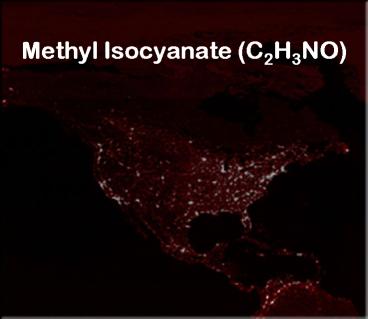Methyl Isocyanate (C2H3NO) - PowerPoint PPT Presentation
1 / 25
Title:
Methyl Isocyanate (C2H3NO)
Description:
Wear protective clothing appropriate to the type and degree of contamination ... Oxygen, ventilatory support, and an intravenous line ... – PowerPoint PPT presentation
Number of Views:747
Avg rating:3.0/5.0
Title: Methyl Isocyanate (C2H3NO)
1
Methyl Isocyanate (C2H3NO)
2
Methyl Isocyanate - Overview
- Physical properties
- Colorless liquid with a very distinct, sharp odor
- Highly flammable with low flash point
- Extremely toxic to people
3
Methyl Isocyanate - Overview
- A chemical intermediate in production of
carbamate insecticides/herbicides - 1984 accidental release in Bhopal, India killed
3-5,000 and injured 170,000
4
Methyl Isocyanate - Toxicity
- Extremely toxic to humans
- Inhalation exposure LD50 lt 200 mg/m3
- Oral exposure LD50 of 50-500 mg/kg
- 23 mg/m3 is irritating to the eyes, nose, and
throat - 68 mg/m3 results in a risk of severe injuries
- 225 mg/m3 may result in death
5
Methyl Isocyanate - Toxicity
- OSHA / NIOSH standards for skin exposure TWA
limit 0.02 ppm (0.05 mg/m3) IDLH 3 ppm
6
Protective Equipment
- Diffuses through polyethylene and attacks most
elastomers - Wear protective clothing appropriate to the type
and degree of contamination - Positive-pressure, self-contained breathing
apparatus (SCBA) is recommended
7
Detection
- No automated detection devices found
8
Decontamination
- Remove victims from the area of exposure, provide
100 O2 if inhalation has occurred - Remove and double-bag contaminated clothing and
personal belongings
9
Decontamination
- Eyes
- Flush with lukewarm water, 15 minutes
- Remove contact lenses
- Skin
- Flush skin and hair with water, 5 minutes
- Wash with soap and water, 15 minutes
- Rinse thoroughly
10
Signs and Symptoms
- Early effects of acute inhalation gaseous
exposure - Eye exposure various adverse effects
- Continued exposure
- Difficulty breathing and cough develops
- Acute pulmonary edema and even acute respiratory
distress syndrome
11
Signs and Symptoms
- Skin irritant causing a burning sensation
- Absorbed through the skin
12
Signs and Symptoms
- Highly toxic with oral exposure
- Reaches most organs in active form
- Systemic effects seen in animal studies
- Other systemic symptoms nausea, gastritis,
sweating, fever, and chills
13
Signs and Symptoms
- Bhopal accident
- Burning eyes most frequent symptom
- Cough associated with poor prognosis
- Other symptoms include diarrhea, shortness of
breath - Many deaths from secondary infections
- Severe changes in lung function, renal tubular
necrosis, reduced liver function
14
Treatment
- Basic first aid for victim
- Primarily supportive treatment
- Treat pulmonary irritation and maintain adequate
ventilation and oxygenation
15
Treatment
- Oral exposures
- Administer activated charcoal slurry (240 mL
water / 30 gm charcoal) - 25 to 100gm in adults and adolescents
- 25 to 50gm in children ages 1 to 12 years
- 1 gm/kg in infants less than 1 year old
- A cathartic may be beneficial
16
Treatment
- Eye exposure
- Liquid
- Extremely irritating
- May cause permanent damage
- Gas
- Irritating
- Rarely causes permanent injury
17
Treatment
- Eye exposure
- Corneal abrasions
- Mydriatics, systemic analgesics, and topical
ophthalmic antibiotics - Severe iritis
- Topical atropine or homatropine
18
Treatment
- Dermal exposure
- Extremely irritating
- Treat topically
- Dermal hypersensitivity reactions
- Systemic or topical corticosteroids or
antihistamines
19
Treatment
- Inhalation
- Oxygen, ventilatory support, and an intravenous
line - For bronchospasm inhaled and/or parenteral
sympathomimetics, IV theophylline, and steroids - Hospitalize and observe all symptomatic patients
for 72 hours for possible delayed pulmonary edema
20
Treatment
- Inhalation
- Pulmonary edema
- Maintain ventilation and oxygenation
- Frequent ABGs or pulse oximetry
- Control hypoxia with O2 supplementation
- IPPB, PEEP mask or intubation
21
Treatment
- Symptomatic patients
- ECG
- Chest x-ray
- Pulse oximetry
- Peak air flows
- Arterial blood gases
- Serum electrolytes
- Renal and hepatic function
22
Long-Term Medical Sequelae
- Bhopal accident
- Chronic eye problems
- Pulmonary damage
- Reproductive effects
- EPA Group D
- Not classifiable as to human carcinogenicity
- Teratogenicity not defined
23
Environmental Sequelae
- Rapidly hydrolyzes when released to moist soil or
to water - Volatilization from dry near-surface soil or
surfaces is likely - Bioconcentration, volatilization and absorption
not significant processes
24
Summary
- Difficult to make and safely store
- Less likely to be a terrorist weapon
- Immediate danger to life and health by inhalation
or oral exposure - Eye irritation to full-blown ARDS, and numerous
serious systemic effects
25
Summary
- Supportive treatment
- Treat pulmonary irritation and maintain adequate
ventilation and oxygenation - 1984 accidental release in Bhopal, India provides
long-term medical consequences data































